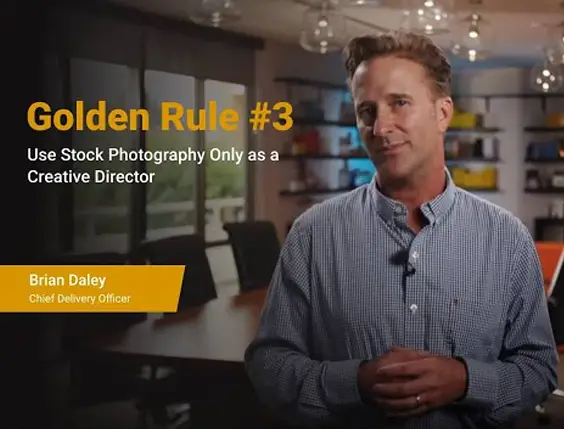

Golden Rule #3 of 20
Use Stock Photography Only as a Creative Director
Ask yourself the following question: “Do I consider what my company does as generic or stock?”
If the answer is yes, then you probably don’t have much to lose in using stock photography.
However, if you’re like the majority of companies in today’s business environment, you are diligently trying to distinguish yourself from your competitors. Therefore, your answer should be a resounding “no way.”
Let’s start with the old cliché, a picture is worth a thousand words. There’s no reason to argue with that, right? So then the next logical question is, “do you want those thousand words to reflect your company’s values and services or be some generic words that almost any company could use?”
Why even use photography on our website?
Photography functions in many capacities when used correctly. Some of the more prominent uses include:
- Add visual drama and excitement
- Communicate important information
- Reinforce copy direction
- Increase rankings in search engines
Doesn’t everybody use stock photography?
Well, you can certainly make a good sounding case for it. After all, it is less expensive, easier to acquire, and there is an unlimited supply to choose from.
But using stock photos immediately cheapens and can discredit the integrity of both the message and the company. It also accomplishes nothing to foster a sense of relationship between the viewer and the company.
Finally, the problem with stock photography is that it looks like, well, stock photography. Even if people viewing your website aren’t calling your company to scold you for using these images, they know it the minute they see it. And you really don’t want that dynamic.

Stock photography should be used by the creative director who is overseeing the design and development of your website.

Jason Lavin
CEO at GoldenComm
During the creation phase of your website design, the designer’s focus is on utilizing graphic design, words, and images to communicate to your audience. We all hope to “get it right” on the first go-around, but that is rarely the case. There are going to be changes in verbal content and imagery before the site goes live. So the stock images are used to give you an idea of what the designer wants to accomplish with photography. These images will also give the photographer an indication of what is to be communicated with the final images.
Let’s look at some examples of websites that have used stock photography and compare to others that utilize custom photography. Can you identify the business that the photograph below is related to?

Let’s try to match a company to the image below taken directly from a prominent website.

So let’s turn the page and look at some more relevant examples.

Here’s an example from one of GoldenComm’s client websites.

Conclusion
You’ve spent tens of thousands of dollars and countless hours making sure that you have effectively communicated what is special about your business and why prospective clients should trust you with their business or personal needs.
Why would you willingly want to compromise all that effort and time and reduce the efficiency of your site by using somebody else’s images? Make the choice to use custom photography and then we can all celebrate our success!

